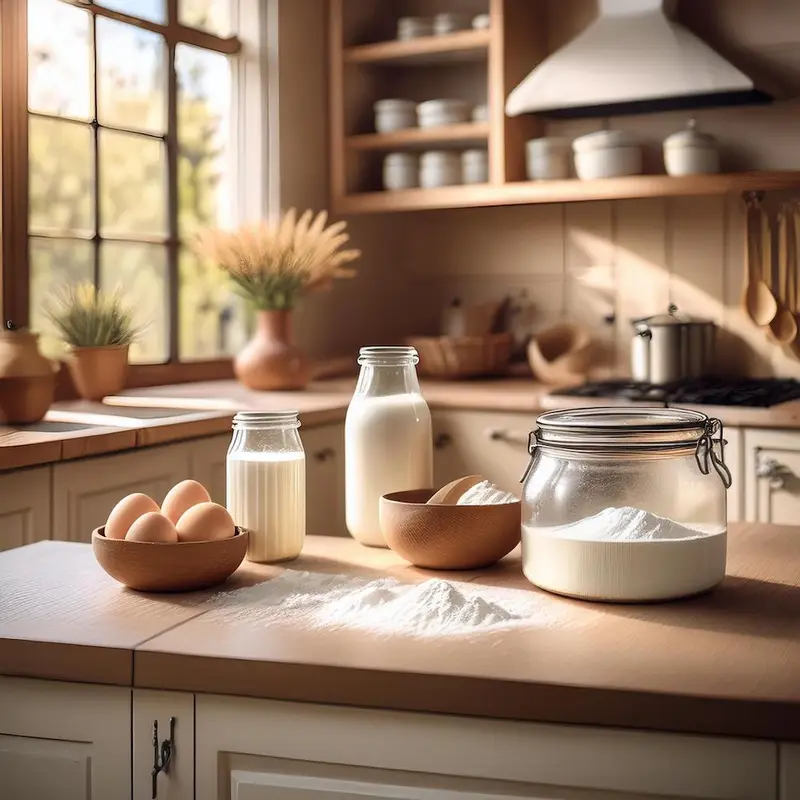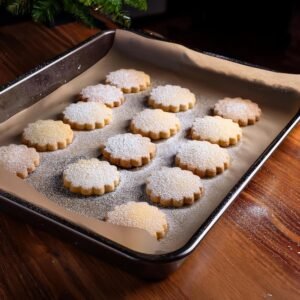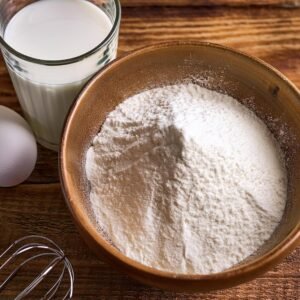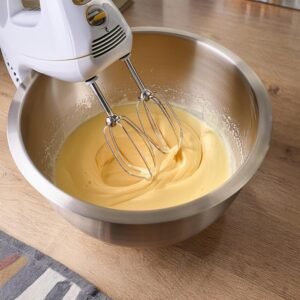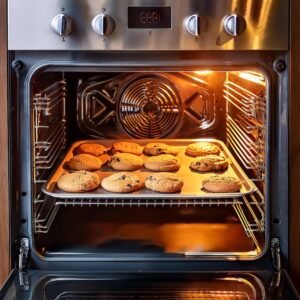Baking soda is one of those ingredients that’s always stocked in a baker’s pantry. From cookies to cakes and quick breads, it’s a key player in helping baked goods rise, become fluffy, and develop a perfect texture. But what happens when you’re out of baking soda? Is it OK to bake without baking soda?
The short answer is yes—you can still bake, but the results will depend on how you adapt your recipe. Baking soda has specific chemical properties that make it unique, so understanding its role and finding suitable substitutes is crucial to ensure your baked goods turn out just as delicious.
In this article, we’ll explore everything you need to know about baking without baking soda, including its role in baking, how its absence affects your recipes, and the best substitutes to use. Whether you’re caught off guard without it or looking for an alternative for dietary reasons, this guide has you covered.
What Is Baking Soda and Its Role in Baking?
Baking soda, scientifically known as sodium bicarbonate, is a staple ingredient in baking. This white, crystalline powder plays a vital role in creating the texture, flavor, and appearance of many baked goods. It is prized for its versatility and effectiveness as a leavening agent, allowing bakers to achieve soft, airy results in a wide range of recipes.
Baking soda’s magic lies in its chemical properties. As an alkaline compound, it reacts with acidic ingredients in recipes to produce carbon dioxide gas. These tiny gas bubbles become trapped in the batter or dough, expanding when exposed to heat in the oven. The result? Fluffy, well-risen baked goods with a tender crumb structure.
Key Functions of Baking Soda in Baking
Baking soda is a multi-functional ingredient that influences several critical aspects of baking:
- Leavening Agent
Baking soda is most commonly known for its role as a leavening agent. When combined with an acidic ingredient like buttermilk, yogurt, or lemon juice, it initiates a chemical reaction that releases carbon dioxide gas. This reaction creates air pockets in the batter or dough, causing it to expand and rise. Without baking soda, recipes that rely on this reaction would result in dense, heavy products. - Acidity Neutralizer
In recipes containing acidic ingredients, baking soda acts as a neutralizer, balancing the overall flavor. For example, in recipes with molasses or sour cream, baking soda helps to tame their tangy or sharp taste, ensuring the final product has a balanced sweetness and richness. - Enhancing Browning
Baking soda contributes to the beautiful golden-brown color of baked goods by promoting the Maillard reaction. This chemical process occurs when sugars and amino acids react under heat, resulting in browning and enhancing the flavor profile of your baked goods. - Texture Enhancer
By creating carbon dioxide gas, baking soda contributes to the structure of the baked goods. It helps produce a tender crumb and prevents the dough from becoming overly dense or chewy. This light, airy texture is especially crucial in recipes like muffins, pancakes, and cakes.
When Is Baking Soda Essential?
Baking soda is indispensable in recipes that include acidic ingredients. Its primary role in these recipes is to react with the acid and create the carbon dioxide bubbles that contribute to rise and texture. Common recipes that rely on baking soda include:
- Quick Breads: Recipes like banana bread, zucchini bread, and cornbread depend on baking soda for their fluffy and moist structure.
- Pancakes and Waffles: Baking soda gives these breakfast staples their light, airy texture and helps them puff up during cooking.
- Cookies: In cookies, baking soda not only helps with spreading and rise but also contributes to a chewy texture and golden-brown appearance.
- Cakes and Cupcakes: Baking soda ensures a soft crumb and proper rise in recipes like chocolate cake or red velvet cake.
- Savory Bakes: Recipes like Irish soda bread or cheese scones use baking soda to achieve their characteristic structure and texture.
Without baking soda, these recipes would lack the rise, fluffiness, and balance of flavors that make them so satisfying. However, understanding baking soda’s role makes it easier to substitute or adjust recipes when necessary.
What Happens If You Bake Without Baking Soda?
If you’re wondering, “Is it OK to bake without baking soda?”, it’s important to understand how its absence affects your baked goods. Here are the most common outcomes:
1. Changes in Texture
Without baking soda, your baked goods will likely be denser. The chemical reaction that produces air bubbles and rise won’t occur, leaving you with a heavier texture.
2. Reduced Rise
Recipes like cakes and muffins depend heavily on baking soda for their fluffy, tall appearance. Omitting it can result in flat, compact baked goods.
3. Unbalanced Flavors
Baking soda neutralizes acidic ingredients, balancing the overall flavor. Without it, your baked goods might taste tangier or less sweet than intended.
4. Paler Appearance
Baking soda contributes to browning through its alkaline nature. Without it, your baked goods may appear lighter in color.
While these effects can significantly alter certain recipes, many baked goods can still turn out delicious with the right adjustments or substitutes.
Recipes That Don’t Need Baking Soda
Not all baked goods rely on baking soda. If you don’t have any on hand, focus on recipes that don’t require leavening agents or use other methods for structure and texture.
1. Yeast-Based Recipes
Recipes like sandwich bread, dinner rolls, and pizza dough use yeast for leavening, so baking soda isn’t necessary.
2. Shortbreads and Cookies
Shortbread cookies and some traditional cookie recipes rely more on butter and sugar for texture than on leavening agents.
3. Crackers and Flatbreads
Crackers and flatbreads don’t require much rise, making them ideal for baking without baking soda.
4. Custards and Cheesecakes
Custards, cheesecakes, and similar desserts don’t need leavening agents at all.
Best Substitutes for Baking Soda
When you’re out of baking soda, there are several alternatives that can mimic its effects. Here are the most effective substitutes and how to use them:
1. Baking Powder
Baking powder is a complete leavening agent, containing both an acid and a base.
How to Use: Replace 1 teaspoon of baking soda with 3 teaspoons of baking powder. Since baking powder already contains acid, you may need to reduce acidic ingredients in your recipe.
Best For: Cakes, muffins, cookies.
2. Self-Rising Flour
Self-rising flour already includes leavening agents and salt.
How to Use: Substitute self-rising flour for all-purpose flour in your recipe, and omit both baking soda and salt.
Best For: Biscuits, quick breads, pancakes.
3. Whipped Egg Whites
Whipping egg whites incorporates air into the batter, providing a natural leavening effect.
How to Use: Beat egg whites until stiff peaks form and gently fold them into the batter.
Best For: Angel food cakes, soufflés, pancakes.
4. Vinegar with Baking Powder
A combination of vinegar and baking powder can mimic baking soda’s reaction.
How to Use: Add 1 teaspoon of vinegar to the wet ingredients and replace baking soda with 3 teaspoons of baking powder.
Best For: Cakes, muffins.
5. Club Soda
The carbonation in club soda can act as a mild leavening agent.
How to Use: Replace some or all of the liquid in your recipe with an equal amount of club soda.
Best For: Pancakes, waffles.
How to Adjust Recipes Without Baking Soda
Baking without baking soda requires some tweaks to maintain balance and structure in your recipes:
1. Compensate for Acidity
Since substitutes like baking powder already contain acid, reduce acidic ingredients like lemon juice or buttermilk.
2. Adjust Texture
If the batter feels too runny or thick after using a substitute, adjust with additional flour or liquid.
3. Modify Baking Times
Baking soda substitutes may affect baking time. Keep an eye on your baked goods to ensure they don’t overcook or undercook.
Common Mistakes and Troubleshooting
Here’s how to avoid and fix issues when baking without baking soda:
1. Dense Texture
Problem: Your baked goods turn out too dense.
Fix: Use whipped egg whites or club soda to add lightness.
2. Flat Appearance
Problem: Cakes or muffins don’t rise properly.
Fix: Opt for baking powder or self-rising flour for a stronger leavening effect.
3. Overly Tangy Flavor
Problem: The recipe tastes too acidic.
Fix: Reduce acidic ingredients like vinegar or lemon juice.
FAQs
What Happens If You Bake Without Baking Soda?
Baking without baking soda can cause:
Loss of Rise: Baked goods may be flatter and denser.
Altered Texture: Heavier and less airy results.
Unbalanced Flavor: Goods might taste tangier or less sweet.
Paler Appearance: Less browning occurs.
Using a substitute like baking powder helps maintain results.
What If I Don’t Have Baking Soda for Baking?
No baking soda? Try these substitutes:
Baking Powder: Use 3 teaspoons for 1 teaspoon of baking soda.
Self-Rising Flour: Swap with all-purpose flour.
Whipped Egg Whites: Adds natural leavening.
Club Soda: Replace some liquid for mild leavening.
Adjust your recipe to achieve similar results.
How Necessary Is Baking Soda?
Baking soda is vital for recipes with acidic ingredients like buttermilk or yogurt. It:
Leavens: Provides rise and a light texture.
Neutralizes Acidity: Balances flavors.
Enhances Browning: Adds a golden color.
For non-acidic recipes, it’s less essential but crucial for quick breads and cookies.
What Happens If I Forgot Baking Soda in Banana Bread?
Without baking soda:
Dense Texture: The bread will be heavier.
Less Volume: It may turn out flat.
Tangy Flavor: Acidity won’t balance.
If caught early, mix baking soda with warm water and fold it in. Otherwise, the bread will still be edible but with a denser texture.
Suggested Internal Links:
- What Can I Use If I Don’t Have Baking Soda?
This article complements the discussion by offering a variety of alternatives for baking soda in general. - What Is a Substitute for Baking Soda in Bread Recipes?
Focuses specifically on bread recipes, providing additional options for readers interested in alternatives. - Banana Bread Recipe Without Baking Soda
Links to a practical application, showcasing a recipe that works without baking soda. - What Can I Use If I Don’t Have Baking Soda for Banana Bread?
Narrowly focuses on banana bread, offering targeted advice for readers exploring baking soda substitutes. - Will Bread Rise Without Baking Soda?
Delves into the science of leavening, enriching the understanding of baking without this key ingredient.
Conclusion
Is it OK to bake without baking soda? Absolutely! While baking soda is a valuable ingredient, understanding how it works and using suitable substitutes like baking powder, self-rising flour, or whipped egg whites can save the day. With the right adjustments, you can bake delicious treats without missing a beat.
So, the next time you’re out of baking soda, don’t stress—use these tips and substitutes to keep baking confidently. Happy baking!
Craving more tasty recipes? Make sure to follow us on Facebook , Instagram, Pinterest, and Twitter for daily updates and kitchen inspiration!
